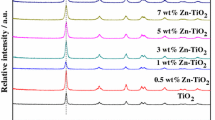Abstract
The TiO2-X% ZnS photocatalysts, where X represents the molar percentage of ZnS (3%, 5%, 10%, and 15%), were synthesized using the one-step sol–gel method. In a Batch-type reactor, under the irradiation of a mercury lamp (λ = 254 nm, Pen-Ray), degradations of 55 ppm 4-chlorophenol were obtained at 400 min with the synthesized photocatalysts: 90% (TiO2), 60% (3% ZnS), 66% (5% ZnS), 74% (10% ZnS), and 58% (15% ZnS). ZnS addition in the photocatalysts inhibits a good performance, being the support, TiO2, the most photoactive material when irradiating in the ultraviolet region. TiO2 showed suppression of hole electron pair recombination and high electron storage, outstanding separation, and transfer.
Graphical abstract





Similar content being viewed by others
Data availability
The data that support the findings of this study are available from the corresponding author upon reasonable request.
References
C. Descorme, Catalytic wastewater treatment: Oxidation and reduction processes. Recent studies on chlorophenols. Catal. Today 297, 324–334 (2017). https://doi.org/10.1016/j.cattod.2017.03.039
F. Li, P. Du, W. Liu, X. Li, H. Ji, J. Duan, D. Zhao, Hydrothermal synthesis of graphene grafted titania/titanate nanosheets for photocatalytic degradation of 4-chlorophenol: solar-light-driven photocatalytic activity and computational chemistry analysis. Chem. Eng. J. 331, 685–694 (2018). https://doi.org/10.1016/j.cej.2017.09.036
A. Kuleyin, Removal of phenol and 4-chlorophenol by surfactant-modified natural zeolite. J. Hazard. Mater. 144(1–2), 307–315 (2007). https://doi.org/10.1016/j.jhazmat.2006.10.036
Z. Duan, W. Zhang, M. Lu, Z. Shao, W. Huang, J. Li, Y. Li, J. Mo, Y. Li, C. Chen, Magnetic Fe3O4/activated carbon for combined adsorption and Fenton oxidation of 4-chlorophenol. Carbon 167, 351–363 (2020). https://doi.org/10.1016/j.carbon.2020.05.106
C. Ferreiro, J. Sanz, N. Villota, A. de Luis, J.I. Lombraña, Kinetic modelling for concentration and toxicity changes during the oxidation of 4-chlorophenol by UV/H2O2. Sci. Rep. 11(1), 1–15 (2021). https://doi.org/10.1038/s41598-021-95083-7
H. Liu, H.K. Shon, X. Sun, S. Vigneswaran, H. Nan, Preparation and characterization of visible light responsive Fe2O3–TiO2 composites. Appl. Surf. Sci. 257(13), 5813–5819 (2011). https://doi.org/10.1016/j.apsusc.2011.01.110
S. Chen, W. Zhao, W. Liu, S. Zhang, Preparation, characterization and activity evaluation of p–n junction photocatalyst p-ZnO/n-TiO2. Appl. Surf. Sci. 255(5), 2478–2484 (2008). https://doi.org/10.1016/j.apsusc.2008.07.115
D. Gupta, R. Chauhan, N. Kumar, V. Singh, V.C. Srivastava, P. Mohanty, T.K. Mandal, Enhancing photocatalytic degradation of quinoline by ZnO: TiO2 mixed oxide: Optimization of operating parameters and mechanistic study. J. Environ. Manage. 258, 110032 (2020). https://doi.org/10.1016/j.jenvman.2019.110032
A. Jbeli, A.M. Ferraria, do Rego, A. M. B., Boufi, S., & Bouattour, S., Hybrid chitosan-TiO2/ZnS prepared under mild conditions with visible-light driven photocatalytic activity. Int. J. Biol. Macromol. 116, 1098–1104 (2018). https://doi.org/10.1016/j.ijbiomac.2018.05.141
A. Franco, M.C. Neves, M.R. Carrott, M.H. Mendonça, M.I. Pereira, O.C. Monteiro, Photocatalytic decolorization of methylene blue in the presence of TiO2/ZnS nanocomposites. J. Hazard. Mater. 161(1), 545–550 (2009). https://doi.org/10.1016/j.jhazmat.2008.03.133
Z.D. Meng, K. Ullah, L. Zhu, S. Ye, W.C. Oh, Synthesis and Characterization of ZnS and ZnS/TiO 2 Nanocomposites and Their Enhanced Photo-decolorization of MB and 1, 5-Diphenyl Carbazide. J. Korean Ceram. Soc. 51(4), 307–311 (2014). https://doi.org/10.4191/kcers.2014.51.4.307
U. Sattar, M. Ikram, M. Junaid, M. Aqeel, M. Imran, S. Ali, Annealing effect on synthesized ZnS/TiO2 nanocomposite for treatment of industrial wastewater. Mater. Res. Express 6(11), 115050 (2019). https://doi.org/10.1088/2053-1591/ab476c
Y. Xiaodan, W. Qingyin, J. Shicheng, G. Yihang, Nanoscale ZnS/TiO2 composites: preparation, characterization, and visible-light photocatalytic activity. Mater. Charact. 57(4–5), 333–341 (2006). https://doi.org/10.1016/j.matchar.2006.02.011
M.B. Marami, M. Farahmandjou, B. Khoshnevisan, Sol–gel synthesis of Fe-doped TiO2 nanocrystals. J. Electron. Mater. 47(7), 3741–3748 (2018). https://doi.org/10.1007/s11664-018-6234-5
V. Štengl, S. Bakardjieva, N. Murafa, V. Houšková, K. Lang, Visible-light photocatalytic activity of TiO2/ZnS nanocomposites prepared by homogeneous hydrolysis. Microporous Mesoporous Mater. 110(2–3), 370–378 (2008). https://doi.org/10.1016/j.micromeso.2007.06.052
J. Dong, W. Fang, H. Yuan, W. Xia, X. Zeng, W. Shangguan, Few-Layered MoS2/ZnCdS/ZnS Heterostructures with an Enhanced Photocatalytic Hydrogen Evolution. ACS Appl. Energy Mater. 5(4), 4893–4902 (2022). https://doi.org/10.1021/acsaem.2c00301
R. Sahraei, S. Darafarin, Preparation of nanocrystalline Ni doped ZnS thin films by ammonia-free chemical bath deposition method and optical properties. J. Lumin. 149, 170–175 (2014). https://doi.org/10.1016/j.jlumin.2014.01.040
Acknowledgments
M. E. Velásquez-Torres thanks CONACYT for the scholarship grant (CVU: 740103). The authors are grateful for the following funding projects: SECTEI/288/2019 8994c19, CONACyT A1-S-41124, SIP-IPN 20221110, SIP-IPN 20220568, UAM 12413443, CONACyT 316022, and A1-S-41124 (-f-3499).
Funding
Not applicable.
Author information
Authors and Affiliations
Corresponding author
Ethics declarations
Conflict of interest
The authors declare that they have no conflict of interest.
Ethical approval
Not applicable.
Informed consent
Not applicable.
Research involving human participants and/or animals
Not applicable.
Additional information
Publisher's Note
Springer Nature remains neutral with regard to jurisdictional claims in published maps and institutional affiliations.
Rights and permissions
Springer Nature or its licensor (e.g. a society or other partner) holds exclusive rights to this article under a publishing agreement with the author(s) or other rightsholder(s); author self-archiving of the accepted manuscript version of this article is solely governed by the terms of such publishing agreement and applicable law.
About this article
Cite this article
Velásquez-Torres, M.E., Tzompantzi, F., Castillo-Rodríguez, J.C. et al. ZnS-doped TiO2 photocatalysts for 4-chlorophenol photodegradation in water. MRS Advances 7, 1189–1192 (2022). https://doi.org/10.1557/s43580-022-00439-4
Received:
Accepted:
Published:
Issue Date:
DOI: https://doi.org/10.1557/s43580-022-00439-4




